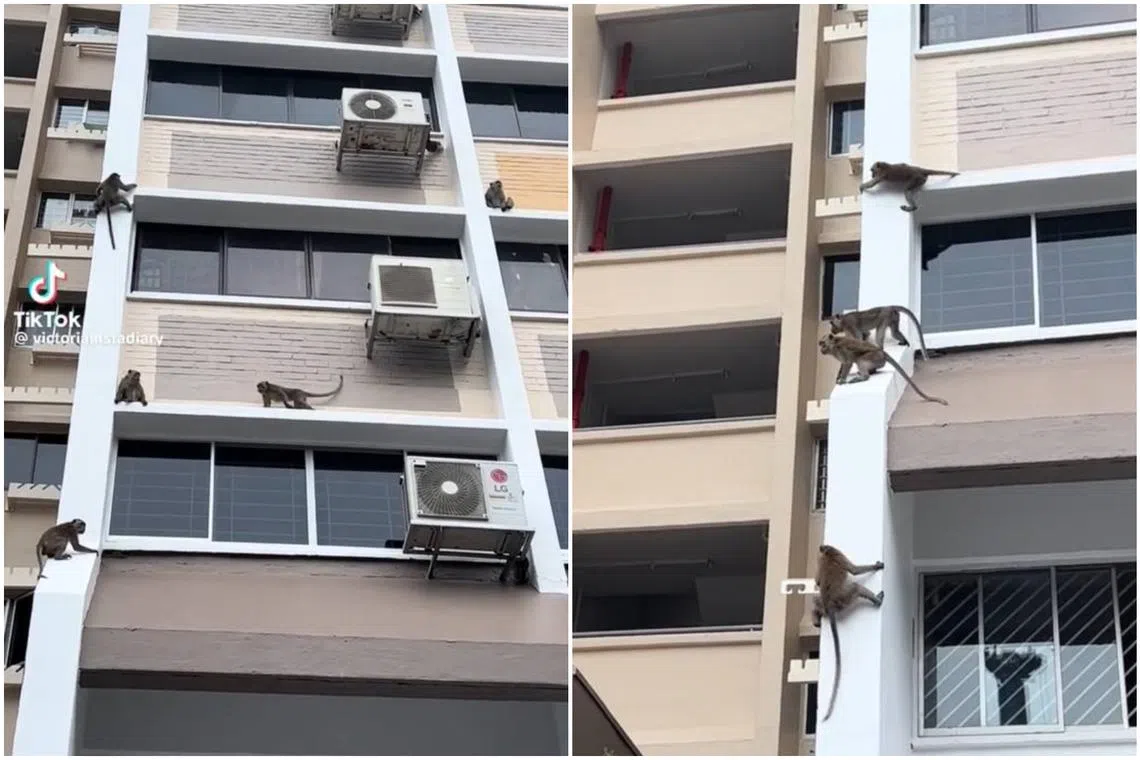NParks monitoring Jalan Besar ‘Mission: Impossible’ monkeys, herding them to forested areas
Sign up now: Get ST's newsletters delivered to your inbox

In a viral TikTok video, the troop of five monkeys can be seen climbing the facade of an HDB block near Jalan Besar MRT station.
PHOTOS: SCREENGRABS FROM VICTORIA LOH/TIKTOK
Follow topic:
SINGAPORE – The National Parks Board (NParks) is monitoring the movements of a troop of monkeys and herding them away from residential areas, after a video of them scaling a Housing Board block in Jalan Besar last Saturday went viral.
In response to queries from The Straits Times, group director of NParks wildlife management Ryan Lee said it is aware of feedback about the long-tailed macaques seen in Veerasamy Road.
He added: “NParks has been monitoring the troop’s movement and carrying out monkey guarding to minimise incursions.”
Monkey guarding refers to the practice of blocking the approach of the animals and herding them away from residential areas and towards the forested ones.
Mr Lee said the macaques in the video are transient, which means they move from one forest plot to another, do not reside in a fixed location and will eventually move on if there are no easily accessible food sources.
Previously spotted in parts of the country near forested areas like Bukit Panjang, Clementi and Punggol, it is understood that this is the first time such monkeys have been seen in Jalan Besar, which is near the city.
Co-chief executive of the Animal Concerns Research and Education Society Anbarasi Boopal said that while there has not been a trend of more monkeys being spotted in central areas of Singapore, the wildlife rescue group received calls in 2019 and 2020 from the public who had seen individual transient monkeys in areas near Kallang River.
Ms Boopal added that as more park connector networks are built across the country, there will be more green spaces which allow wildlife to move around to find food, a mate or a new troop.
“If (the monkeys’) habitat is disturbed due to development, they will also be forced to move to another green pocket, and cross built-up areas in the process,” said Ms Boopal.
“With plans to have a park 10 minutes away from each household by 2030, we are bringing nature closer to us, which would mean wildlife encounters will be inevitable.”
Ms Boopal said the monkeys might have come from the central catchment area or the east of Singapore.
“Long-tailed macaques are forest fringe creatures which move between forest patches in search of food and territory,” said Mr Lee, who added that NParks adopts a combination of measures to manage their population.
This includes conducting studies to understand the population ecology of macaques, minimising human sources of food by ensuring proper waste disposal, habitat modification including removal of fruit trees, and working with stakeholders to carry out sterilisation as a long-term measure.
“We are also engaging residents and shopkeepers in the area to keep food items out of sight and to dispose waste properly, and also share with them how they should respond when encountering macaques,” added Mr Lee.
“If macaques approach you in the open, remain calm and quiet and do not make any sudden movement or maintain eye contact with them. Instead, look away and back off slowly.”
He also advised people to keep plastic bags out of sight if they spot macaques, as the animals tend to associate these bags with the presence of food.
The video of the macaques in Jalan Besar was posted to TikTok by user Victoria Loh and has garnered more than four million views. It shows the monkeys skilfully wrapping their limbs around a wall column, sliding down and jumping onto a nearby shelter.
The slick moves prompted comments likening them to comic book superhero Spider-Man and characters in the Mission: Impossible action movies.


